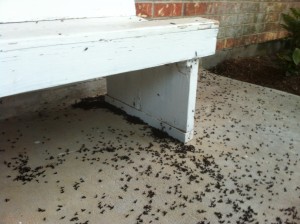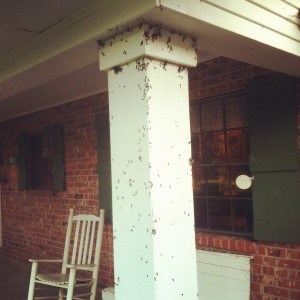It’s Love Bug season in Louisiana.
This timely short story is from Hearts across the Water written after Hurricanes Katrina and Rita in 2005.

Black Bugs
Over and over in the days leading up to the hurricane’s arrival people used this statement that reveals the human tendency to look for the silver lining in even the darkest cloud, “Well, at least Rita will wash away the black bugs.”
We heard variations on that many times.

What (printable) names have you heard them called?
Well, Rita passed and all was quiet and bug free … for two days. Then on Sunday, the day after the storm, they were back. The hated black bugs had returned. I’m not sure where they rode out the storm but they evidently weren’t blown north because they were still out in force.
Now if you don’t live in areas where the black bugs come twice yearly you may not understand this story. How could an infestation of non-biting non-stinging insects cause such consternation?
These black bugs, which are really black with orange, are called “love bugs” in the Southern Gulf coastal areas of the United States. This is due to their usually being found in mating pairs as they fly about.
Their scientific name is Plecia neartica. Their emergence twice yearly, in May and September, is always a topic of disgust and great conversation. Instead of the causal, “It sure is hot today,” people lament, “Have you ever seen the black bugs worse than this?” That is why their being blown away to Arkansas or Tennessee was such a conversation starter.
Their arrival, especially in the fall during mid-September, occurs in Egyptian plague proportions. They are everywhere. For some reason they are attracted to anything white. Our Adult Center, “The White House” becomes a huge love bug magnet during this time. You can sweep them off the porches in piles.

The one-sided love affair between love bugs and vehicles is interesting. According to the University Of Florida Department Of Agriculture, love bugs are attracted to automobile exhaust fumes during daylight hours as the day’s temperatures warm up. Hot engines and the vibrations of vehicles also contribute to why these black bugs are found along highways and around vehicles.
Because of their attraction to gasoline fumes, any visit to the gasoline pumps is an ordeal in black bug swatting. Once I observed a well-dressed lady in a white Lincoln Continental gassing up at a convenience store. If she’d been a teenager I would have sworn she was dancing. Her swatting, gyrations, cussing, and obvious physical discomfort were all testimony to the pure aggravation of these insects.
It would be easy for an outsider to claim, “Well, don’t they don’t bite or sting so they can’t be that bad.” But spending weeks fighting a plague of love bugs them off could test even the patience of Mother Teresa.
The worst result of our love bug invasions is the damage they do to vehicles. During the heat of the day they love to swarm along roadsides. Along roadsides they are so thick that car vehicles will sometimes overheat due to the radiator grills being clogged with dead black bugs.
Additionally, the splat of the bugs on the windshield can obscure vision. Turning on your wipers, even with the washer, creates a special Louisiana gumbo of smashed wet love bugs that makes vision even worse.
A road trip through love bug country results in hundreds of dead bugs all over the front of one’s vehicle. There is an acidic quality to the love bug bodies that causes them to not only stick but to “etch” the paint job if the dead bugs remain on the painted surfaces of vehicle. Left on the front of a car or truck for several days in the hot sunshine results in them nearly adhering to the paint. Washing them off is a chore requiring lots of hot water, soap, and elbow grease.
After Katrina many relief workers from outside the South came to help us. One of my best friends Paul Dear, who works for Sprint, told me this story:
A carload of Sprint workers from Ohio came down to help in Southern Louisiana after Katrina. They were great help as this telecommunications company tried to help recover from the communications chaos from the storm. Of course these Midwesterners had never seen anything like the love bugs. The sheer mass proportion of these insects fascinated them.
Their comment was, “I can’t wait to get home and tell folks about these black bugs. I’ve never seen anything like them.” Paul said they refused to wash the front grill of their car because “they wanted to show folks back home how thick the bugs were.” I’m sure the folks in Ohio were impressed with the thousands of dead black bugs plastered on the front grill.
All I know is that if you took a South Louisianan to a large parking lot in Ohio where the Sprint worker is parked, he could easily pick out their pock-marked vehicle -a lasting souvenir of their visit to our gulf coast.
In spite of two hurricanes in a month in Louisiana, these unwelcome guests refused to leave. Despite hurricane winds that blew away roofs and felled century old trees, the black bugs, those “love bugs that we all hate” somehow held on and survived the storm. And they were waiting to welcome everyone back Rita evacuees returned home.
Then the week after Hurricane Rita is when the other black bugs arrived in southwest Louisiana.

These new visitors were just as unwelcome as the love bugs. They were Salt Marsh Mosquitoes. These large dark biters are much more aggressive than our normal local skeeters. They have the audacity to attack you right out in the sunny part of day. Salt-marsh mosquitoes are also called floodwater mosquitoes. They normally are found in the coastal marsh areas.
I remember once reading about the crash of a small plane in the marshes of Cameron Parish. The pilot of the Cessna fortunately suffered only minor injuries. Because he was transporting a large shipment of marijuana, he was flying below radar and had filed no flight plan. When his plane crashed upside down in the middle of the desolate marsh, no one was alerted to search for him. So he spent three days sitting on the wing of the plane hoping for discovery.
Rescuers who got to him in a boat said the drug runner had nearly gone crazy from fighting the Salt Marsh mosquitoes. His body was completely covered with welts from three days of attack. One old Cameron trapper commented, “Whatever jail time he gets won’t be near as bad as three days of attack by the black marsh mosquitoes.”
These big aggressive dark mosquitoes normally stay in the brackish marsh areas of the coast. But when a flood or storm occurs, they can travel up to 500 miles with a storm. Normally they stay within 30-50 miles of marsh areas. Jim Olson, a “bug expert” or professor of entomology at Texas A & M shares this about our post-Rita attackers. “Add water, wait seven days, and cover (yourself) up.”
The eggs can lay unhatched for as long as two years until a high water event turns them loose.
At least these big black skeeters don’t carry West Nile. The salt-marsh species, officially of the Aedes species, don’t carry disease but are large, vicious, and aggressive.
In a Houston Chronicle article of Thursday, October 6, 2005 Olson shared how “they take advantage of a direct hit from a storm in unique ways. They’re able to hide in grass and avoid being blown away by wind. But when the storm surge hits, they ride it inland like surfers into new territory.”
My fertile imagination could just see both of these insect species holding hands in the grass with as the storm winds blew everything down across the landscapes of Cameron, Calcasieu parishes, and then northward to Beauregard. Then there is the equally imaginative vision of them gleefully surfing up the storm surge from Big Lake and the Intracoastal Waterway to happily greet the returning evacuees of Southwestern Louisiana.
Yes, Southwestern Louisiana,
My home.
The best place I know to live.
Home of the black bugs- Love bugs and Salt Marsh mosquitoes.
Do you have black love bugs where you live?
 Creekbank Stories Curt Iles, Storyteller
Creekbank Stories Curt Iles, Storyteller

One comment
Pingback: Why I actually like winter